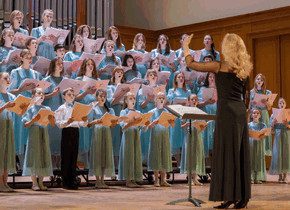
Singing a choir: what is it for and what methods to use?
Contents
 Choral performance has a strong impact on a large audience of listeners. To achieve such a result you have to work hard. Stable regular rehearsals and rehearsals are necessary. The study and nuance of the repertoire by the choir begins with chanting. Let’s explore together the purpose of choir singing.
Choral performance has a strong impact on a large audience of listeners. To achieve such a result you have to work hard. Stable regular rehearsals and rehearsals are necessary. The study and nuance of the repertoire by the choir begins with chanting. Let’s explore together the purpose of choir singing.
Warming up the ligaments
Waking up in the morning, a person feels that there is some hoarseness in his voice. During the night, the vocal muscles “froze” from inactivity. And quite some time passes until a feeling of freedom of speech appears.
Consequently, it is quite understandable that in order to tune in to active singing, the vocal cords need to be “warmed up” – this is an important rule of vocal hygiene for any vocalist. You can start warming up the cords by singing in unison with your mouth closed. Then move on to vowel sounds. Start with the sounds of the primary zone, moving up and down the range.
Development of vocal skills
Singing requires you to develop the following skills: breathing, sound production and diction. For example, to develop a short inhalation, fast exercises are performed, slow exercises are performed for a calm inhalation. In the process of chanting, they learn chain breathing; soft, hard and aspirated attack. Possible types of sound management and clear articulation are practiced. To do this, you can go through the main steps of the mode (mi-i-i-i, ya-a-a-e), using legato and staccato strokes. During periods of choir singing, the director has the opportunity to get acquainted with the sound of the voices of individual singers and help them eliminate certain shortcomings.
Developing Choral Skills
Choral skills include intonation and ensemble. The ensemble must develop when the choir sings in all directions – rhythm, structure, tempo, diction, dynamics. For example, the use of vibration in the choir is prohibited due to instability of intonation. The exception is the solo part.
Elements of polyphony during chanting contribute to the harmonious development of choristers. The best exercises for developing a well-rounded singing ensemble are arpeggios and diatonic scales. Rhythm is well practiced by stamping the strong beat of the bar and clapping the weak beat (mainly for children’s choirs). Coherence is the success of any team. And therefore it is very important to achieve simultaneity in all aspects of singing in a choral group.
Learning difficult episodes of a piece
Almost every work has various difficulties. These can be harmonic dissonances, roll calls of parts, polyphony, different character of sounds, slow tempo, complex rhythm (quintole, sextole, dotted rhythm). It is more effective to practice all this in the relaxed atmosphere of singing in a choir. Only through careful practice of individual segments of the score can professional performance be achieved.
************************************************** **********************
Properly organized choir singing gives amazing results in the process of preparing the pieces to be learned. It is an active way of mastering the multifaceted aspects of vocal and choral art.



